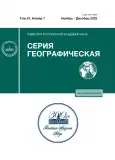Changes in the Functional Use of the Space of Dagestan Settlements in the Conditions of Socioeconomic Transformations of Mountainous Territories
- Authors: Ershov A.M.1, Imangulov L.R.1, Savoskul M.S.1
-
Affiliations:
- Moscow State University, Faculty of Geography, Department of Economic and Social Geography of Russia
- Issue: Vol 87, No 7 (2023)
- Pages: 977-991
- Section: ТРАНСФОРМАЦИИ ФУНКЦИОНАЛЬНЫХ И ПРОСТРАНСТВЕННЫХ СТРУКТУР ГОРНЫХ РЕГИОНОВ И ГОРНЫХ СООБЩЕСТВ
- URL: https://journals.rcsi.science/2587-5566/article/view/231693
- DOI: https://doi.org/10.31857/S2587556623070063
- EDN: https://elibrary.ru/AHICIX
- ID: 231693
Cite item
Full Text
Abstract
The article considers the transformation of the settlement structure of the Dagestan mountainous territories and changes in the daily use of the mountain villages’ space as an interconnected process using the evolutionary-functional principle and the principle of multi-scale. To achieve the study objectives, a typology of the mountainous and foothill territories of Dagestan was carried out based on the analysis of the population of settlements, their high-altitude and center-peripheral position. Further, in accordance with the typology carried out, key villages were selected to study the directions of transformation of the villages’ space functional use by their residents. In addition to statistical data, the study is based on the materials of three expeditions to the Republic of Dagestan in 2020–2022. The authors surveyed 10 districts and more than 30 rural settlements. The methodology of the mountain villages’ survey is based on the method of field observations, expert and narrative interviews. In addition, as the key most typical mountain villages, the features of the use of public spaces by residents of the five settlements of Fiy, Tsumada, Echeda, Tlokh, Gubden are considered in detail (data on other surveyed settlements were used to identify common patterns in the space use). As a study result, it was revealed that the dynamics, internal differentiation and the nature of the use by residents of mountain villages’ public territories is determined by the settlements’ geographical location, the preservation of agrarian functions, the religious factor and to a lesser extent the ethno-cultural differences of local communities, which are more pronounced in mountainous Dagestan compared to other regions of the North Caucasus. The assumption was confirmed that the transformations taking place in the functional use of the village at the local level are the result of socio-cultural changes taking place at the regional and country levels.
About the authors
A. M. Ershov
Moscow State University, Faculty of Geography, Department of Economic and Social Geography of Russia
Author for correspondence.
Email: alexiusershov@ya.ru
Russia, Moscow
L. R. Imangulov
Moscow State University, Faculty of Geography, Department of Economic and Social Geography of Russia
Author for correspondence.
Email: linar.imangulov.1999@mail.ru
Russia, Moscow
M. S. Savoskul
Moscow State University, Faculty of Geography, Department of Economic and Social Geography of Russia
Author for correspondence.
Email: savoskul@yandex.ru
Russia, Moscow
References
- Артоболевскй С.С., Бакланов П.Я., Трейвиш А.И. Пространство и развитие России: полимасштабный анализ // Вестн. РАН. 2009. № 2. С. 101–112.
- Гуня А.Н. Институциональное реструктурирование географического пространства: влияние приватизации земель на горные ландшафты Северного Кавказа. Saarbrücken: Palmarium acad. publ., 2013. 143 с.
- Имангулов Л.Р. Роль горных условий в трансформации сельской местности (на примере Самурской долины республики Дагестан) // УЭПС: управление, экономика, политика, социология. 2021. № 3. С. 89–97. https://doi.org/10.24412/2412-2025-2021-3-89-97
- Капустина Е.Л. Глобальное селение: судьба локальности применительно к современной социальной жизни в Дагестане // ИАЭК. 2019. № 4. С. 769–782.
- Капустина Е.Л. История трансформации дагестанского праздника // История, археология и этнография Кавказа. 2021. № 4. С. 985–1001.
- Карпов Ю.Ю. Взгляд на горцев. Взгляд с гор: Мировоззренческие аспекты культуры и социальный опыт горцев Дагестана. СПб.: Петербургское Востоковедение, 2007. 656 с.
- Карпов Ю.Ю., Капустина Е.Л. Горцы после гор. Миграционные процессы в Дагестане в XX – начале XXI века: их социальные и этнокультурные последствия и перспективы. СПб.: Петербургское Востоковедение, 2011. 448 с.
- Ковалев С.А. Сельское расселение (географическое исследование). М.: Изд-во Моск. ун-та, 1963. 371 с.
- Кузнецова О.В. Типология факторов социально-экономического развития регионов России // Вестн. Моск. ун-та. Сер. 5. География. 2014. № 2. С. 3–8.
- Куркиева Х.М. Институциональные факторы территориальной дифференциации социально-экономических характеристик сельских поселений (на примере Ингушетии) // Региональные исследования. 2012. № 1. С. 94–101.
- Любимова Г.Н., Хан-Магомедов С.О. Народная архитектура южного Дагестана: Табасаранская архитектура. М.: Госстройиздат, 1956. 104 с.
- Махмудова З.У. Дагестан на переломе эпох: этнографические экспедиции Е.М. Шиллинга / Сб. Музея антропологии и этнографии. Народы Кавказа: музейные коллекции, исследования объектов и явлений традиционной и современной культуры. СПБ.: МАЭ РАН, 2015. С. 85–102.
- Мовчан Г.Я. Старый аварский дом в горах Дагестана и его судьба: По материалам авт. обследований 1945–1964 гг. М.: ДМК Пресс, 2001. 527 с.
- Мудуев Ш.С. Географические особенности трансформации сельского расселения и хозяйства Дагестана в 1990-е гг. Автореф. дис. … д-ра геогр. наук. М.: Институт географии РАН, 2004. 48 с.
- Набиева У.Н. Культурная география Дагестана. М.: Институт Наследия, 2002. 210 с.
- Стародубровская И.В. Межпоколенческие отношения и социальные трансформации на примере Северного Кавказа // Социология власти. 2019. № 1. С. 92–113. https://doi.org/10.22394/2074-0492-2019-1-92-113
- Стародубровская И.В., Зубаревич Н.В., Соколов Д.В., Интигринова Т.П. Северный Кавказ: модернизационный вызов. М.: Дело, 2011. 325 с.
- Ткаченко А.А. Подходы к созданию общей теории территориальной организации общества // Вестн. Моск. ун-та. Сер. 5. География. 2008. № 1. С. 21–26.
- Трейвиш А.И. Географические факторы модернизации общества: некоторые уроки Всемирной и Российской истории XIX–XX веков. Вестн. Моск. ун-та. Сер. 5. География. 2017. № 6. С. 3–8.
- Штейнберг И.Е. Метод “длинного стола” в качественных полевых социологических исследованиях // Мониторинг общественного мнения: экономические и социальные перемены. 2021. № 5. С. 493–516.
- Щитова Н.А., Соловьёв И.А., Белозёров В.С. Дагестан: модель межкультурного взаимодействия в полиэтническом регионе // Наука. Инновации. Технологии. 2018. № 4. С. 91–104.
- Kalbarczyk E., et al. Transformation of public space in rural areas-identification and assessment of the state of development in selected communes in the Greater Poland voivodeship // Acta Scientiarum Polonorum Administratio Locorum. 2020. № 2. P. 77–84.
- Mantey D., Kępkowicz A. Types of public spaces: The polish contribution to the discussion of suburban public space // The Professional Geographer. 2018. № 4. P. 633–654.
Supplementary files














